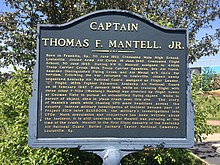This day in history: Thomas Mantell, the pilot of a P-51 Mustang fighter plane, crashed while in pursuit of an unidentified flying object near the town of Franklin, Kentucky, thus becoming the first person known to have died as a result of a UFO sighting on this day in 1948.
On January 7 in 1948 the Godman Army Airfield at Fort Knox, Kentucky, received a report from the Kentucky Highway Patrol of an unusual flying object near Madisonville. Reports of a westbound circular object, 250–300 feet in diameter. At about 1:45 p.m., Sergeant Quinton Blackwell saw an object from his position in the control tower at Fort Knox. Two other witnesses in the tower also reported a white object in the distance. Colonel Guy Hix, the base commander, reported an object he described as "very white," and "about one fourth the size of the full moon ... Through binoculars it appeared to have a red border at the bottom ... It remained stationary, seemingly, for one and a half hours." Observers at Clinton County Army Air Field in Ohio described the object "as having the appearance of a flaming red cone trailing a gaseous green mist" and observed the object for around 35 minutes. Another observer at Lockbourne Army Air Field in Ohio noted, "Just before leaving it came to very near the ground, staying down for about ten seconds, then climbed at a very fast rate back to its original altitude, 10,000 feet, leveling off and disappearing into the overcast heading 120 degrees. Its speed was greater than 500 mph in level flight."
Four F-51D Mustangs of C Flight, 165th Fighter Squadron Kentucky Air National Guard—one piloted by Captain Thomas F. Mantell—were already in the air and told to approach the object. Blackwell was in radio communication with the pilots throughout the event. One pilot's Mustang was low on fuel and he quickly returned to base. The other two pilots accompanied Mantell in steep pursuit of the object. They later reported they saw an object but described it as so small and indistinct that they could not identify it. Mantell ignored suggestions that the pilots should level their altitude and try to more clearly see the object. Ruppelt notes that there was some disagreement amongst the air traffic controllers as to Mantell's words as he communicated with the tower: some sources reported that Mantell had described an object "[which] looks metallic and of tremendous size," but according to Ruppelt, others disputed whether or not Mantell actually said this.
Only one of Mantell's wingmen, Lt. Albert Clements, had an oxygen mask, and his oxygen was in low supply. Clements and the third pilot, Lt. Hammond, called off their pursuit at 22,500 feet (6,900 m). However, Mantell continued to climb. According to the United States Air Force, once Mantell passed 25,000 feet he blacked out from lack of oxygen and his plane began spiraling back towards the ground. A witness later reported Mantell's Mustang in a circling descent. His plane crashed on a farm south of Franklin, on Kentucky's border with Tennessee. Firemen later pulled Mantell's body from the wreckage. His seat belt was shredded and his wristwatch had stopped at 3:18 p.m., the time of his crash. Thirty minutes later the UFO was no longer visible to observers at Godman Army Airfield.
The Mantell incident was reported by newspapers around the nation, and received significant media attention. A number of sensational rumors were also circulated about the crash. According to UFO historian Curtis Peebles, among the rumors were claims that "the flying saucer was a Soviet missile; it was [an alien] spacecraft that shot down [Mantell's fighter] when it got too close; Captain Mantell's body was found riddled with bullets; the body was missing; the plane had completely disintegrated in the air; [and] the wreckage was radioactive." However, no evidence has ever surfaced to substantiate any of these claims, and Air Force investigation specifically refuted some claims, such as the supposedly radioactive wreckage. Ruppelt wrote that, "I had always heard a lot of wild speculation about the condition of Mantell's crashed F-51, so I wired for a copy of the accident report. [It] said that...Mantell's body had not burned, not disintegrated, and was not full of holes; the wreck was not radioactive, nor was it magnetized." Mantell was the first member of the Kentucky Air National Guard to die in flight. According to John Trowbridge, historian of the Kentucky National Guard, "There is a real X-Files twist to this, too. Mantell lived almost his entire life in Louisville, but he was born in a hospital in Franklin, only a few miles from where he was killed."
Historian David M. Jacobs argues the Mantell case marked a sharp shift in both public and governmental perceptions of UFOs. Previously, the press often treated UFO reports with a whimsical or glib attitude reserved for “silly season news.” Following Mantell's death, however, Jacobs notes "the fact that a person had died in an encounter with an alleged flying saucer dramatically increased public concern about the phenomenon. Now a dramatic new prospect entered thought about UFOs: they might be not only extraterrestrial but potentially hostile as well."
Later investigation by the United States Air Force's Project Blue Book indicated that Mantell may have died chasing a Skyhook balloon, which in 1948 was a top-secret project that he would not have known about.



No comments:
Post a Comment